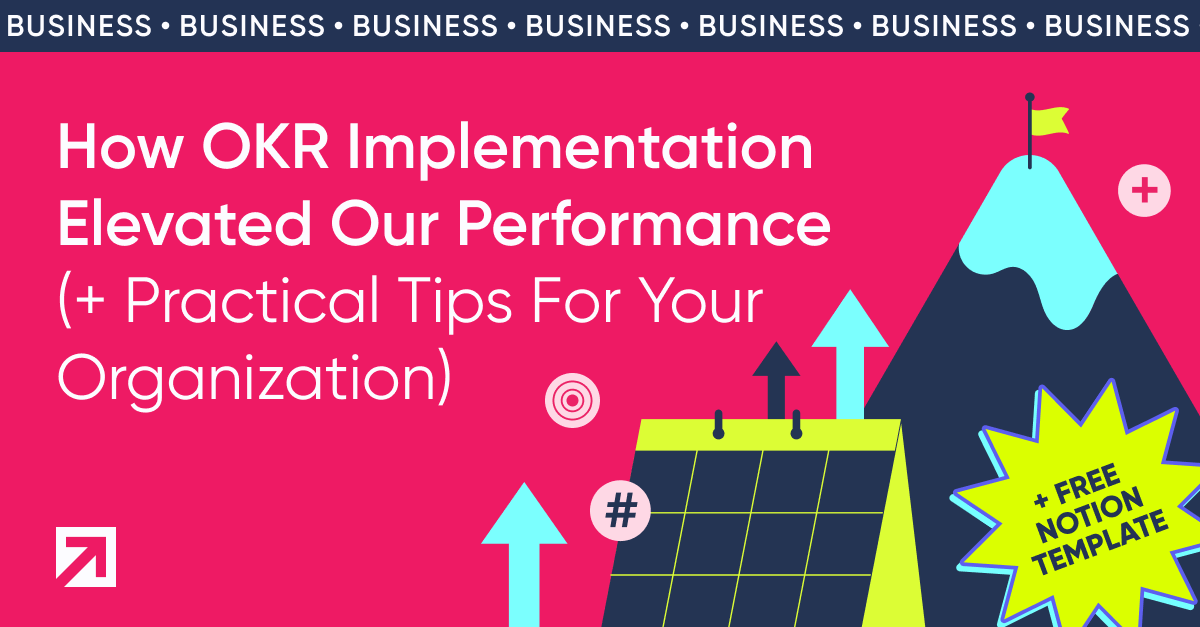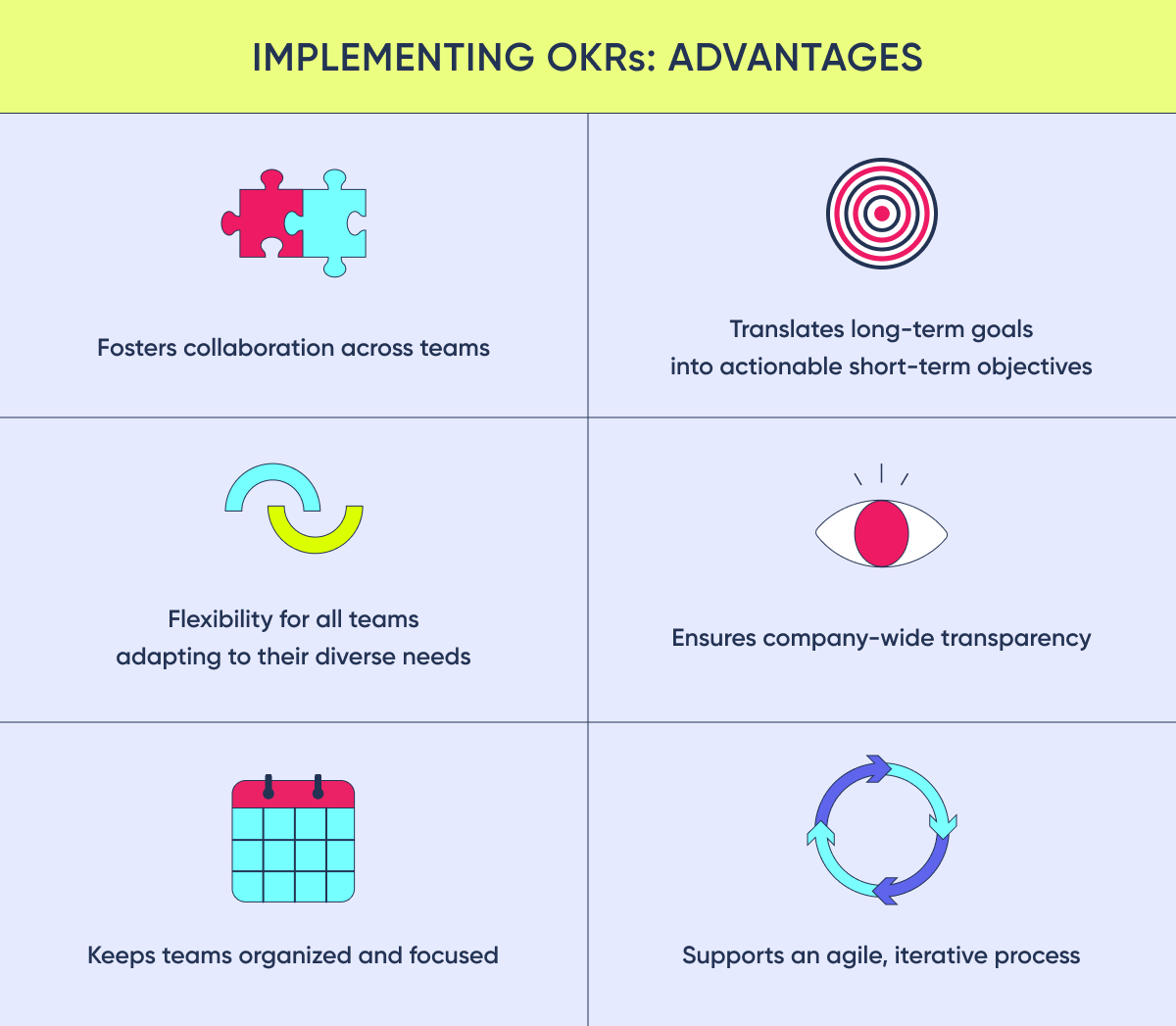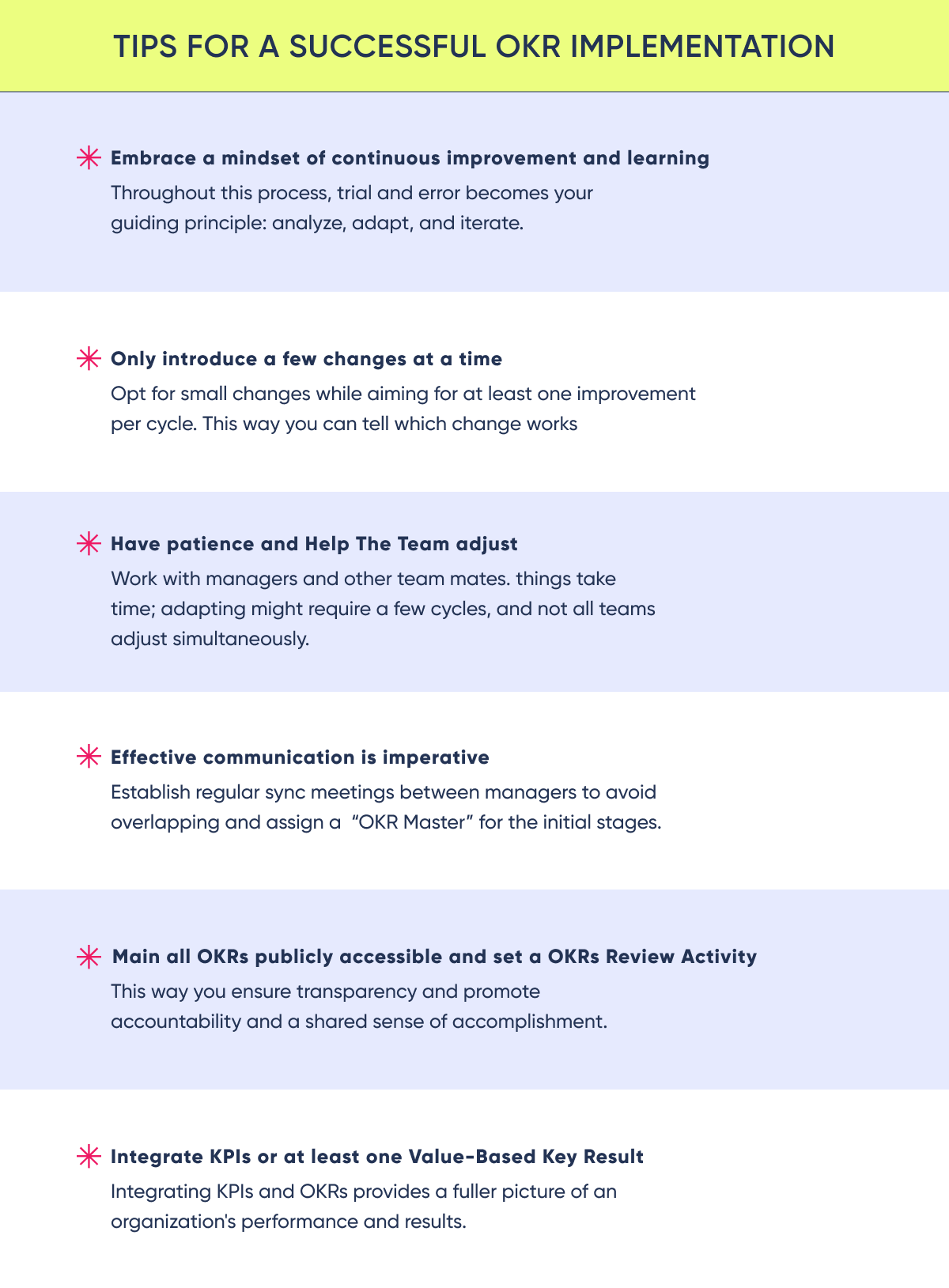

Embarking on our OKR journey three years ago marked a key moment in our path to achieving organizational efficiency. At that point, we needed a robust but flexible framework. A system that would foster collaboration, translate long-term aspirations into actionable short-term objectives, and have the flexibility to adapt to the diverse needs of all our teams. Transparency, organization, and an agile approach were non-negotiable elements on our checklist, and the OKR framework introduced by Andrew Grove in the 1970s for Intel checked all the boxes.
Even before introducing the framework, we were conscious of the inherent challenges, particularly in introducing a company-wide framework designed to set priorities and manage goals. The initial resistance to change is a common hurdle, but for frameworks like OKRs, where a smooth adoption translates into achieving company and team goals, overcoming this resistance is a must.
Keep reading this blog post to uncover how we navigated through challenges and overcame resistance to implement a framework that has become essential to our daily operations. Don’t miss the insights and lessons learned over our three-year journey, which could be invaluable for your own path.
The first step: Putting theory into practice
At first, adapting OKRs to our needs took more work than we thought. In the first two quarterly cycles, we experimented with approaches that weren't the best fit for our organization. Yet, thanks to its agile nature, we pivoted and found a way that made OKRs work for us. Throughout this process, trial and error became our guiding principle: analyze, adapt, and iterate.
As the cycles passed and the methodology within our teams strengthened, we continued introducing new ideas within the framework, hoping it would help us reach our goals more effectively. Here's a helpful tip: only introduce a few changes at a time, as it can be difficult to pinpoint which change worked and which didn't. Instead, opt for small changes while aiming for at least one improvement per cycle.
Here are some key lessons from our first OKRs cycles:
- Embrace a mindset of continuous improvement and learning. You will for sure make mistakes, the important thing is to learn from them and adapt.
- Remember, things take time; adapting might require a few cycles, and not all teams will adjust simultaneously. Have patience and work with each team manager to help them adjust.
- Assign someone as an “OKR Master” (just like the Scrum masters in Scrum) to ensure the seamless implementation of the framework, at least in the initial stages.
OKRs become a pillar of our organization
We firmly believe that OKRs should serve as one of the fundamental pillars upon which our company stands. However, this requires us to focus on several key aspects and principles.
Firstly, it's crucial to recognize that OKRs are designed to bring alignment across the entire company. They emphasize the importance of understanding that our goals are collective, so we need collaborative efforts from every team. OKRs have proven to be key in aligning teams and fostering collaboration. Through this framework, we've improved our culture of teamwork, where different teams work towards shared objectives.
However, this approach has challenges, particularly in coordinating various teams working on the same goal from different perspectives. This could potentially lead to tasks and activities from different teams overlapping. Effective communication is imperative in addressing this issue. Establishing regular sync meetings between managers can facilitate alignment and mitigate overlap.
Furthermore, OKRs have significantly enhanced transparency within our organization. Maintaining all OKRs publicly accessible enables every organization member to know its priorities, which teams are tasked with what OKRs, and the current status of each OKR. To further promote transparency, we've set up an OKRs review activity where teams present their results and achievements to the entire company, fostering accountability and a shared sense of accomplishment.

KPIs: taking the OKR framework to the next level
When diving into the sea of OKRs, discussions about KPIs (Key Performance Indicators) naturally arise. KPIs serve as valuable measurement tools, offering concrete metrics and indicators. However, KPIs often provide isolated numbers that lack context or direction for the team. While it's possible to use OKRs and KPIs independently, combined, they can produce far more effective results. Why? Because KPIs are daily operational performance metrics, and OKRs guide long-term strategic objectives. Employing both provides a fuller picture of an organization's performance and results.
But how do we integrate OKRs and KPIs? It begins with a deeper exploration of KRs (Key Results). Key results are specific goals that measure progress toward the objective. They must be specific and measurable, as said by John Doerr's statement: "I will (Objective) as measured by (set of Key Results)."
There are two types of key results: activity-based and value-based.
- Activity-based key results focus on completing activities or delivering “projects”. This type of KRs typically start with verbs such as launch, create, develop, deliver, build, implement, define, test, prepare, and plan.
- Value-based key results measure the outcomes of successful activities or projects aiming to deliver value to the organization or clients. They often follow the format: Increase, maintain, or reduce X metric from value A to value B.
Why emphasize these distinctions? We aim to foster a culture focused on results and not focused on tasks or activities. If we had completed all the activities and nothing improved, we wouldn't have been really successful, so relying only on activity-based key results falls short. Here's where KPIs come into play. As measurable metrics, KPIs can serve as excellent key results within OKRs, facilitating a smooth integration of both frameworks.
But what if KPIs still need to be established within your organization? While the ideal course of action would involve developing organizational and team KPIs, there's no need to panic. You can still effectively implement OKRs by gradually incorporating value-based key results into your OKRs, ensuring each objective includes at least one value-based key result alongside activity-based ones. This approach establishes a way to measure added value and sets clear success criteria, ensuring a smoother integration of OKRs and KPIs over time.

Recap: The most valuable lessons we learned from implementing OKRs
Throughout our journey with OKRs, we've encountered numerous challenges. Each offered valuable lessons from which we've gained precious insights and learnings. Here's a recap of some of the most crucial lessons we've learned:
- No magic recipe: customization is key. As previously emphasized, there's no one-size-fits-all approach to implementing OKRs. While there's a lot of information online, including success stories and implementation guides, it's essential to remember that each organization is unique. What worked for others may not necessarily work for you, and vice versa. Adapting the framework to suit the specific needs and dynamics of your teams and organization is crucial.
- If it doesn’t have a number, it’s not a key result. A fundamental aspect of key results is their specificity and measurability. If a key result lacks a numerical component, it's not truly measurable. We've previously highlighted the importance of prioritizing value-based key results over activity-based ones and avoiding turning key results into mere task lists. Concrete numerical key results ensure clarity and accountability in measuring outcomes.
- Balancing ambition with realism: OKRs should be ambitious, driving teams toward significant achievements. However, excessive ambition, also known as "moonshots," can result in challenges or problems such as demotivation, loss of commitment, and alignment issues. Achieving the right balance between ambition and realism is crucial. While one OKR can be set as a moonshot, it's prudent to balance it with more attainable objectives, also known as "roofshots," ensuring sustained progress without overwhelming teams.
- Weekly check-ins: vital for cadence. Integrating OKRs into our daily work structure through weekly check-ins is indispensable to prevent them from becoming mere goals forgotten in drawers. We know you are probably thinking, “More meetings? No, thank you.” However, we've found that weekly check-ins are crucial in maintaining focus towards our goals. By combining these check-ins with the weekly planning sessions of each team, we optimize efficiency and use our time more effectively. These brief but essential meetings serve as crucial checkpoints in our journey toward achieving our OKRs, ensuring alignment and accountability across the organization.
By internalizing these lessons and all the others we’ve collected through this blog post, we've refined our approach to OKRs, driving our way for greater alignment and success.

Conclusion: embracing the journey ahead
As we conclude this blog post, we reflect on our journey with OKRs. Through challenges, errors, and triumphs, we've learned invaluable lessons that have shaped our approach toward greater clarity, teamwork, accountability, and alignment. From customization and measurable key results to finding the right balance between ambition and realism, our journey with OKRs has been one of continual growth and adaptation (and will certainly continue to be in the future). In the future, we look to stay committed to embracing the possibilities that OKRs offer, and we'd like to share them with as many people as possible. In this spirit of sharing we decided to publish the notion page we've created for tracking our OKRs progress. You can download the free template here. Hope it's useful and helps you achieve all you set out to get!


